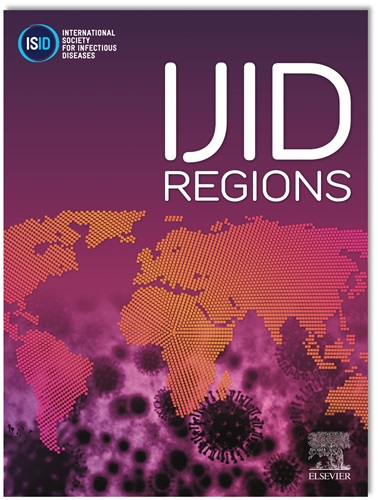侵袭性乳糖不良链球菌亚种的出现。西班牙的equissimilis(2012-2022):基因组分析和临床相关性。
IF 4.8
2区 医学
Q1 INFECTIOUS DISEASES
引用次数: 0
摘要
目的:乳酸不良链球菌亚种的增加。SDSE感染已在世界范围内记录在案。本研究旨在分析西班牙11年成人中由SDSE (iSDSE)引起的侵袭性疾病。方法:我们对2012年至2022年在贝尔维奇大学医院(HUB)检测到的iSDSE (n=89)和2018年在西班牙三家医院收集的分离株(n=22)进行了回顾性的实验室研究。收集HUB的临床数据。对分离株进行抗菌药敏试验(EUCAST 2023)、全基因组测序(WGS)和移动遗传元件(MGEs)分析。用小鼠模型分析毒力。结果:HUB的iSDSE发作主要发生在有合并症(糖尿病、慢性心脏病、恶性肿瘤,尤其是)的老年患者中。WGS显示出较高的遗传多样性,CC15、CC17和CC20是最常见的世系。鉴定出各种毒力因子,包括超抗原speG。大环内酯类药物、林可胺类药物和四环素类药物的耐药率最高(超过27%),并且随着时间的推移而变化,与多种MGEs有关。小鼠模型强调了CC20-stG62647谱系的毒力,但这些结果与临床数据不一致。结论:iSDSE发病率呈上升趋势,且与老年患者合并症相关。遗传上,SDSE具有多样性,具有整合携带抗性决定因子的MGEs的高能力。小鼠模型研究显示CC20-stG62647谱系的毒力增强。这些发现强调了对这种新出现的病原体进行持续监测的必要性。本文章由计算机程序翻译,如有差异,请以英文原文为准。
Emergence of invasive Streptococcus dysgalactiae subsp. equisimilis in Spain (2012-2022): genomic insights and clinical correlations
Objectives
An increase in Streptococcus dysgalactiae subsp. equisimilis (SDSE) infections has been documented worldwide. This study aims to analyze invasive disease caused by SDSE (iSDSE) in adults over an 11-year period in Spain.
Methods
We conducted a retrospective, laboratory-based study of iSDSE detected at Hospital Universitari de Bellvitge (HUB) from 2012 to 2022 (n = 89) and isolates collected in three Spanish hospitals in 2018 (n = 22). Clinical data from HUB were collected. Isolates were tested for antimicrobial susceptibility (European Committee on Antimicrobial Susceptibility Testing 2023), subjected to whole genome sequencing and analyzed for mobile genetic elements (MGEs). A mouse model was used to analyze virulence.
Results
iSDSE episodes at HUB occurred predominantly in older patients with comorbidities (particularly, diabetes, chronic heart disease, and malignancies). Whole genome sequencing revealed a high genetic diversity, with the most common lineages being CC15, CC17, and CC20. Various virulence factors, including the superantigen speG, were identified. Macrolides, lincosamides, and tetracyclines exhibited the highest resistance rates (>27%) and changed over time, linked to multiple MGEs. The mouse model highlighted the virulence of the CC20-stG62647 lineage, but these results were discordant with clinical data.
Conclusion
iSDSE incidence is increasing and associated with older patients with comorbidities. Genetically, SDSE is diverse with a high capacity to integrate MGEs carrying resistance determinants. Mouse model studies showed the enhanced virulence of the CC20-stG62647 lineage. These findings underscore the need for ongoing surveillance of this emerging pathogen.
求助全文
通过发布文献求助,成功后即可免费获取论文全文。
去求助
来源期刊
CiteScore
18.90
自引率
2.40%
发文量
1020
审稿时长
30 days
期刊介绍:
International Journal of Infectious Diseases (IJID)
Publisher: International Society for Infectious Diseases
Publication Frequency: Monthly
Type: Peer-reviewed, Open Access
Scope:
Publishes original clinical and laboratory-based research.
Reports clinical trials, reviews, and some case reports.
Focuses on epidemiology, clinical diagnosis, treatment, and control of infectious diseases.
Emphasizes diseases common in under-resourced countries.

 求助内容:
求助内容: 应助结果提醒方式:
应助结果提醒方式:


